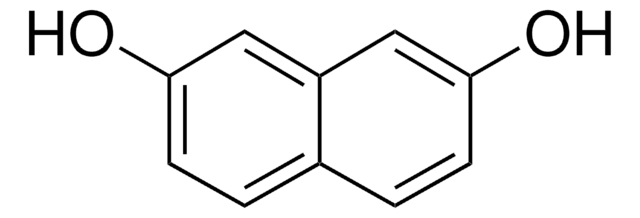Transportation information can be found in Section 14 of the product's (M)SDS.To access the shipping information for this material, use the link on the product detail page for the product.
410217
2′,7′-Dichlorofluorescein
ACS reagent
Synonym(s):
Dichlorofluorescein; Fluorescein 27
About This Item
Recommended Products
grade
ACS reagent
Quality Level
form
powder
technique(s)
titration: suitable
color
orange to red-brown, powder
mp
280 °C (dec.) (lit.)
solubility
alcohol: passes test
density
0.790 g/cm3
λmax
509 nm
suitability
passes test for adsorption indicator
application(s)
diagnostic assay manufacturing
hematology
histology
storage temp.
room temp
SMILES string
Oc1cc2Oc3cc(O)c(Cl)cc3C4(OC(=O)c5ccccc45)c2cc1Cl
InChI
1S/C20H10Cl2O5/c21-13-5-11-17(7-15(13)23)26-18-8-16(24)14(22)6-12(18)20(11)10-4-2-1-3-9(10)19(25)27-20/h1-8,23-24H
InChI key
VFNKZQNIXUFLBC-UHFFFAOYSA-N
Looking for similar products? Visit Product Comparison Guide
General description
Application
Storage Class Code
11 - Combustible Solids
WGK
WGK 3
Flash Point(F)
Not applicable
Flash Point(C)
Not applicable
Personal Protective Equipment
Choose from one of the most recent versions:
Already Own This Product?
Find documentation for the products that you have recently purchased in the Document Library.
Customers Also Viewed
-
What is the Department of Transportation shipping information for this product?
1 answer-
Helpful?
-
-
What can be used to make a solution of 2´,7´-dichlorofluorescein?
1 answer-
2´,7´-Dichlorofluorescein is soluble at 25 mg/mL absolute ethanol with heating. 2´,7´-Dichlorofluorescein is also soluble in water at 0.1 mg/mL.
Helpful?
-
-
In what types of applications can 2´,7´-Dichlorofluorescein be used?
1 answer-
Some applications for use of 2´,7´-Dichlorofluorescein are listed below. This product can be used for the determination of carbohydrates by fluorescence densitometry after TLC. See G. Gübitz et al., J. Chromatogr., 117, 337, (1976). 2´,7´-Dichlorofluorescein as also been used in the determination of H2O2 by chemiluminescence. See the following references by H. Watanabe et al. Anal. Sci. 2, 461, (1986) and T. Segawa et al. Anal. Sci. 6, 763, (1990). This product has also been used as a fluorescent additive used in indirect fluorimetric detection in OTC-HPLC. See W.D. Pfeffer and E.S. Yeung, J. Chromatogr., 506, 401, (1990).
Helpful?
-
-
What excitation /emission wavelengths are best for fluorescence detection of 2´,7´-Dichlorofluorescein?
1 answer-
2´,7´-Dichlorofluorescein can be detected at an excitation wavelength at 504 nm and emission wavelength at 529 nm in 0.1 M Tris pH 8.0.
Helpful?
-
Active Filters
Our team of scientists has experience in all areas of research including Life Science, Material Science, Chemical Synthesis, Chromatography, Analytical and many others.
Contact Technical Service













